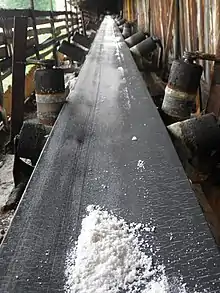Drohobych salt plant
Drohobych salt plant in the existence from 1250 is the oldest working salt plant in Drohobych, Lviv region, Ukraine. It has been working since 1250.
| Industry | Salt production |
|---|---|
| Founded | 1250 |
| Headquarters | Drohobych, Lviv region, Ukraine |
| Products | salt |
History

Drohobych salt plant has been in operation since the 13th century and maybe even earlier on the territory close to sources of raw materials called "salt brine". The foundation of the salt plant was in 1250, and it is believed that this plant is the oldest working industrial company in Ukraine. During this time, Drohobych was one of the richest cities in the Carpathian region making this important in the history of the last decades in the existence of the Galicia-Volyn principality.
Drohobych's growth was caused by the salt manufactory, which provided not only Galician, Transcarpathia but also Volun, Holm, and Kiev regions with salt. In 1339 Drohobych was occupied by Polish seigniors and the Drohobych salt manufactory became the part of the royal property. At that time salt was the most famous good produced in Drohobych. Chumaks from the entire Ukraine (Podillya, Brtislav, and Volun regions) came to Drohobych to purchase salt.
Volyn piers (found on the river Sluch and Horyn) were used to load Drohobych salt on the ships (called "komyaha"), then the salt was transported to Prypyat, and after that it was shipped along Dnipro straight to Kyiv. The towers in Drohobych, Yasenytsya, and other surrounding villages belonged to the king. Peasants were forced to work for the king. The king never visited Drohobych.
Rich Italian merchants rented salterns (salt water pools), because they had caravans traveling from Italy through Lviv and Bukovyna to Crimean city Kapha. During the 14th and 15th centuries these merchants were the intendants and the main workers of the saltern in Drohobych. This benefited King and merchants alike. Italians marchants produced high-quality salt, thus greatly expanding trade relations between Drohobych and Europe, however, this brought many conflicts in Drohobych. These conflicts were caused by citizens' opinion that only some people were seeing profit while and others did not. Conflict in 1491, between Italians merchants with Drohobych citizens was resolved with the help of king's decree.
The king declared that people have to produce a cart (containing 6000 salt barrels). In the years after this, each citizen entering Drohobych was charged 3 dinnars per cart of either salt or other goods. Money was used to keep the Drohobych city streets in good condition. According to documents dating back to 1768, it is known that the upper layer of the road situated in Zhupna street (which exists today) was made of wood. The territory between the saltern and Zhupna Street was joined by the bridge constructed above the river Pobuk. At that time two wells could be found on the territory of Drohobych saltern: the King's saltern and baron Hartenberg's private saltern.
Proceeds from both of these two salters were used to fund Cathedral hospital called "The hospital for the poor". According to documents from 1565, 26,000 barrels of salt was produced in Drohobych; half of this was produced in King's saltern and other half by private salterns. Nowadays, Drohobych salt is producing two types of salt of the high quality.